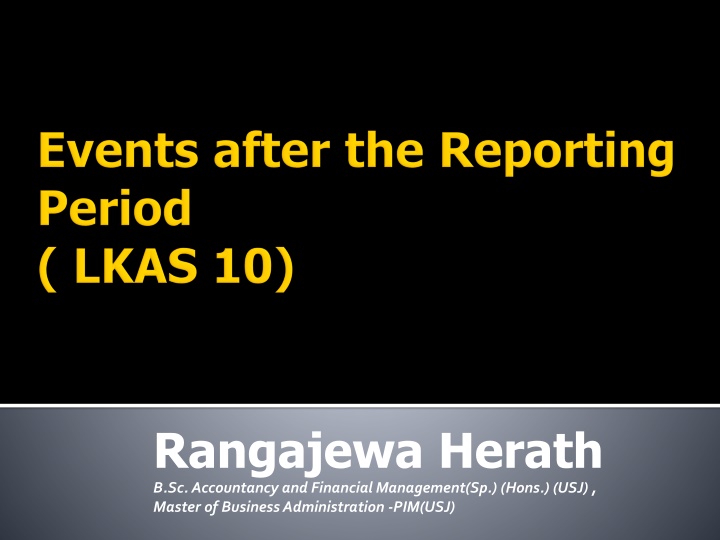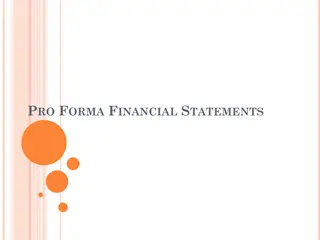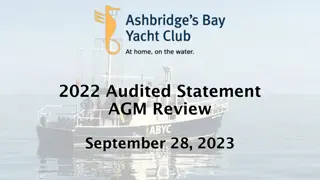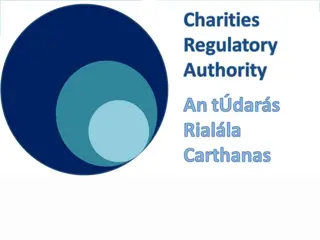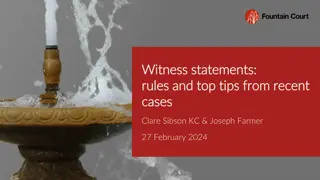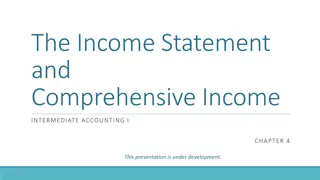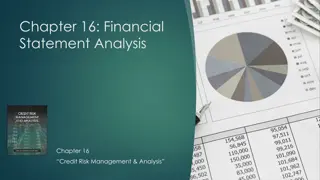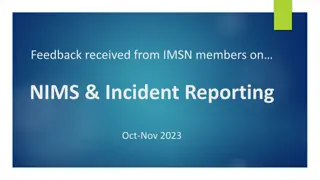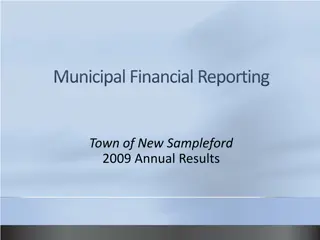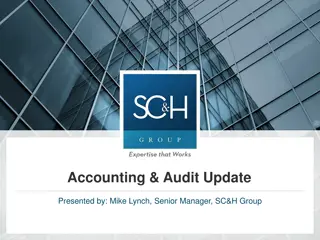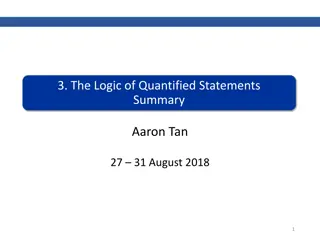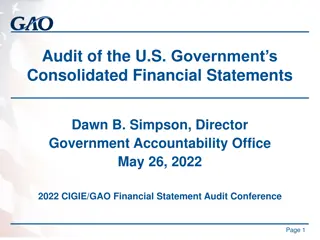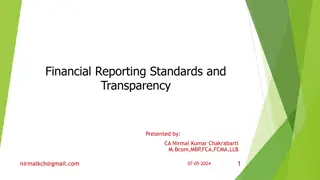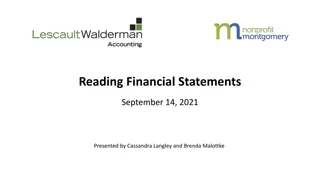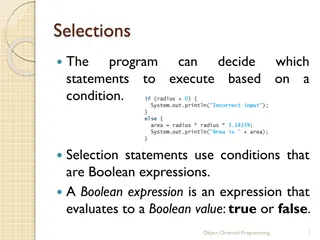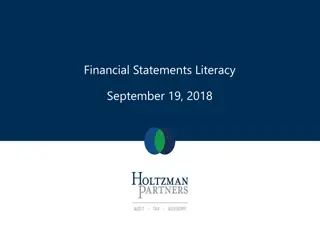Events After the Reporting Period in Financial Statements
This standard guides entities on adjusting their financial statements for events occurring after the reporting period and prescribes disclosures regarding post-reporting events. Entities must apply this standard in accounting for and disclosing such events, distinguishing between adjusting and non-adjusting events. The entity should reflect adjusting events in the financial statements, such as the settlement of court cases confirming past obligations. Non-adjusting events provide evidence of conditions post reporting, influencing disclosures and possibly indicating a need to reassess going concern assumptions.
Download Presentation

Please find below an Image/Link to download the presentation.
The content on the website is provided AS IS for your information and personal use only. It may not be sold, licensed, or shared on other websites without obtaining consent from the author.If you encounter any issues during the download, it is possible that the publisher has removed the file from their server.
You are allowed to download the files provided on this website for personal or commercial use, subject to the condition that they are used lawfully. All files are the property of their respective owners.
The content on the website is provided AS IS for your information and personal use only. It may not be sold, licensed, or shared on other websites without obtaining consent from the author.
E N D
Presentation Transcript
Rangajewa Herath B.Sc. Accountancy and Financial Management(Sp.) (Hons.) (USJ) , Master of Business Administration -PIM(USJ)
The objective of this Standard is to prescribe: (a) when an entity should adjust its financial statements for events after the reporting period; and (b) the disclosures that an entity should give about the date when the financial statements were authorised for issue and about events after the reporting period. The Standard also requires that an entity should not prepare its financial statements on a going concern basis if events after the reporting period indicate that the going concern assumption is not appropriate.
This Standard shall be applied in the accounting for, and disclosure of, events after the reporting period.
Events after the reporting period are those events, favourable and unfavourable, that occur between the end of the reporting period and the date when the financial statements are authorisedforissue. Twotypes ofeventscanbeidentified:
(a) those that provide evidence of conditions that existed at the end of the reporting period (adjusting events after the reporting period); and (b) those that are indicative of conditions that arose after the reporting period (non-adjusting events after the reporting period)
Reporting Period Date that financial statements are authorized for issue 01/04/ 2015 31/03/ 2016 30/06/ 2016 Events after the reporting period Adjusting Events Non-Adjusting Events
An entity shall adjust the amounts recognised in its financial statements to reflect adjusting events after the reporting period.
(a) the settlement after the reporting period of a court case that confirms that the entity had a present obligation at the end of the reporting period. The entity adjusts any previously recognized provision related to this court case in accordance with LKAS 37 Provisions, Contingent Liabilities and Contingent Assets or recognizes a new provision. The entity does not merely disclose a contingent liability because the settlement provides additional evidence that would be considered in accordance with paragraph 16 of LKAS 37.
(b) the receipt of information after the reporting period indicating that an asset was impaired at the end of the reporting period, or that the amount of a previously recognized impairment loss for that asset needs to be adjusted. For example: (i) the bankruptcy of a customer that occurs after the reporting period usually confirms that a loss existed at the end of the reporting period on a trade receivable and that the entity needs to adjust the carrying amount of the trade receivable; and (ii) the sale of inventories after the reporting period may give evidence about their net realizable value at the end of the reporting period.
(c) the determination after the reporting period of the cost of assets purchased, or the proceeds from assets sold, before the end of the reporting period. (d) the determination after the reporting period of the amount of profit-sharing or bonus payments, if the entity had a present legal or constructive obligation at the end of the reporting period to make such payments as a result of events before that date (see LKAS 19 Employee Benefits). (e) the discovery of fraud or errors that show that the financial statements are incorrect.
An entity shall not adjust the amounts recognized in its financial statements to reflect non-adjusting events after the reporting period. If non-adjusting events after the reporting period are material, non-disclosure could influence the economic decisions that users make on the basis of the financial statements. Accordingly, an entity shall disclose the following for each material category of non-adjusting event after the reporting period: (a) the nature of the event; and (b) an estimate of its financial effect, or a statement that such an estimate cannot be made.
(a) a major business combination after the reporting period (SLFRS 3 Business Combinations requires specific disclosures in such cases) or disposing of a major subsidiary; (b) announcing a plan to discontinue an operation; (c) major purchases of assets, classification of assets as held for sale in accordance with SLFRS 5 Non-current Assets Held for Sale and Discontinued Operations, other disposals of assets, or expropriation of major assets by government; (d) the destruction of a major production plant by a fire after the reporting period; (e) announcing, or commencing the implementation of, a major restructuring (see LKAS 37);
If an entity declares dividends to holders of equity instruments (as defined in LKAS 32 Financial Instruments: Presentation) after the reporting period, the entity shall not recognise those dividends as a liability at the end of the reporting period.
Provisions, Contingent Liabilities and Contingent Assets (LKAS 37) 14
1. Legal obligation Legal obligations may arise due to; operations of contractual law (through its explicit or implicit terms); operation of provisions in parliament acts; or operations of other law. 16
2. Constructive obligations Constructive obligations may arise due to, established pattern of past practice, published policies or a sufficiently specific current statement, the enterprise has indicated to other parties that it will accept certain responsibilities; or, valid expectations created by enterprise on the part of those other parties that it will discharge those responsibilities 17
A contingent liability is: a possible obligation that arises from past events and whose existence will be confirmed only by the occurrence or nonoccurrence of one or more uncertain future events not wholly within the control of the enterprise. 18
A contingent asset is: a possible asset that arises from past events and whose existence will be confirmed only by the occurrence or nonoccurrence of one or more uncertain future events not wholly within the control of the enterprise. 19
